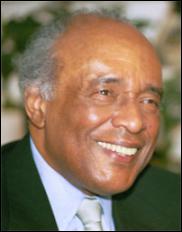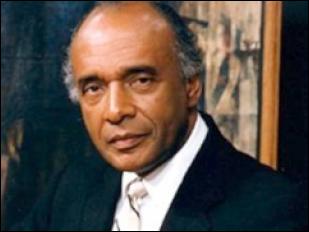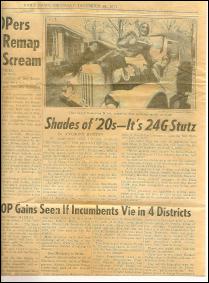Gil Noble: Pianoman, Broadcaster, Tenaciously Human
Gil Noble: Pianoman, Broadcaster, Tenaciously Human
By SUZAN MAZUR


GIL
NOBLE
The news that legendary television broadcaster Gil Noble had a serious stroke earlier this year made me pause to think about how he touched my life. It was just before Christmas 1971 that I first met Gil, not long after New York publishing houses braced for a storming by the women's liberation movement, inspired by the successes of the black struggle in America.
Gil and I had both been invited to a press conference at Tavern-on-the-Green in Central Park where East Europe Import-Export Co. was introducing a Soviet-bloc jeep. Gil was 39, rather distinguished I thought, but otherwise perfect as a WABC Eye Witness News anchorman.
Two years out of college, I was Outdoors columnist at Popular Mechanics with the nom de plume Sam Mazur. I was also the magazine's Environment Editor writing with my own name, having recently lateralled from Good Housekeeping, another Hearst publication, where GH's managing editor thankfully recognized that I was not sufficiently enthused about baking stories or reading the slush manuscripts of Pearl Buck in her later years.
Gil had been rewarded with the WABC television anchor spot in 1968 for his excellent reporting from Newark during the civil rights movement, but had other talents. He had worked in industry prior to joining ABC in 1967, at Union Carbide. And, not surprisingly, he'd been a fashion model. So he knew how to sell an image -- an East European jeep needed a woman in fur.
I may have been the only woman at the Tavern-on-the-Green press conference, clearly the only one wearing fur. So Gil asked if I'd pose with the car. I agreed.
Once on top of the Romanian M-461, Gil handed me a grease gun. The shot launched my modeling career really, although my fashion runway experience would not begin for a few more years.


Click to enlarge images
Suzan Mazur with grease gun atop Romanian M-461 jeep, New York Daily News (l); her column for Popular Mechanics, nom de plume Sam Mazur (r)"
In gratitude, sometime after the Christmas and New Year holidays I invited Gil for supper. It was the peace-love 1970s and the invitation was an innocent gesture.
He accepted. I never even thought to ask if he was married.
I had recently moved from the Upper East Side to the West Village, which was still very residential and without a profusion of restaurants. People entertained at home. So I shopped for dinner around the corner on Bleecker Street at the health food store Woody Allen dubbed "The Happy Carrot".
Gil arrived wearing a Yukon jacket with fur-trimmed hood. I vaguely remember him describing an assignment that warranted an insulated coat. But New York winters were also seriously cold in those years and Gil's family roots were Jamaican.
He was charming, kidding that he was 51 years old.
My studio apartment was sparsely furnished, mostly rattan I did have a "dining room" though, where we sat down to a meal of leafy greens and assorted beans, sharing bits and pieces of our life stories.
Television networks were under pressure to racially diversify in the late 60s. Gil told me that he had been asked to take speech lessons in order to drop his Harlem accent. Our conversation otherwise never got around to a discussion of racism.
I had inherited a piano with my West 12th Street $100-a-month apartment, but didn't actually play although my piano had recently been tuned. Gil, I soon learned, did play (his rendition of "My Funny Valentine" was flawless). In fact, for a while Gil played jazz piano around town with his own trio. He is still on the board of New York's Jazz Foundation of America.
Gil was thrilled to hear about my first trip through Africa some years later following my return to journalism, interviewing Mary Leakey and other scientists in East and West Africa.
And I continually marveled at his tenacity in exposing social injustice on Like It Is, the television show he produced and hosted for four decades on ABC, from his interviews with brutally addicted drug users in Harlem to his talks with leaders of Africa's freedom struggles. In 2002, he successfully fought off cancellation of the program over such candid conversations. The show now without Gil has been reframed and renamed, the jury out as to whether it effectively serves the community.
Gil could have chosen a gorgeous life as an entertainer. Instead, we are richer for his noble decision to tell it like it is.
 Suzan Mazur
is the author of The
Altenberg 16: An Exposé of the Evolution
Industry. Her reports have appeared in the
Financial Times, The Economist, Forbes,
Newsday, Philadelphia Inquirer,
Archaeology, Connoisseur, Omni and
others, as well as on PBS, CBC and MBC. She has been a
guest on McLaughlin, Charlie Rose, and various
Fox Television News programs. For some years along the way,
she was a runway fashion model for Giorgio Sant' Angelo,
Geoffrey Beene, Bill Blass and other legendary designers.
Email: sznmzr@aol.com
Suzan Mazur
is the author of The
Altenberg 16: An Exposé of the Evolution
Industry. Her reports have appeared in the
Financial Times, The Economist, Forbes,
Newsday, Philadelphia Inquirer,
Archaeology, Connoisseur, Omni and
others, as well as on PBS, CBC and MBC. She has been a
guest on McLaughlin, Charlie Rose, and various
Fox Television News programs. For some years along the way,
she was a runway fashion model for Giorgio Sant' Angelo,
Geoffrey Beene, Bill Blass and other legendary designers.
Email: sznmzr@aol.com


 Binoy Kampmark: Closed For Business - The Oddities Of Trump’s Tariffs
Binoy Kampmark: Closed For Business - The Oddities Of Trump’s Tariffs Martin LeFevre - Meditations: Teach Children The Distinction Between The World And Nature
Martin LeFevre - Meditations: Teach Children The Distinction Between The World And Nature Ramzy Baroud: Civil War On The Horizon? The Ashkenazi-Sephardic Conflict And Israel’s Future
Ramzy Baroud: Civil War On The Horizon? The Ashkenazi-Sephardic Conflict And Israel’s Future Gordon Campbell: On The Government’s Latest Ferries Scam
Gordon Campbell: On The Government’s Latest Ferries Scam Peter Dunne: Dunne's Weekly - While We're Breaking Up Monoliths, What About MBIE?
Peter Dunne: Dunne's Weekly - While We're Breaking Up Monoliths, What About MBIE? Adrian Maidment: Supermarket Signs
Adrian Maidment: Supermarket Signs